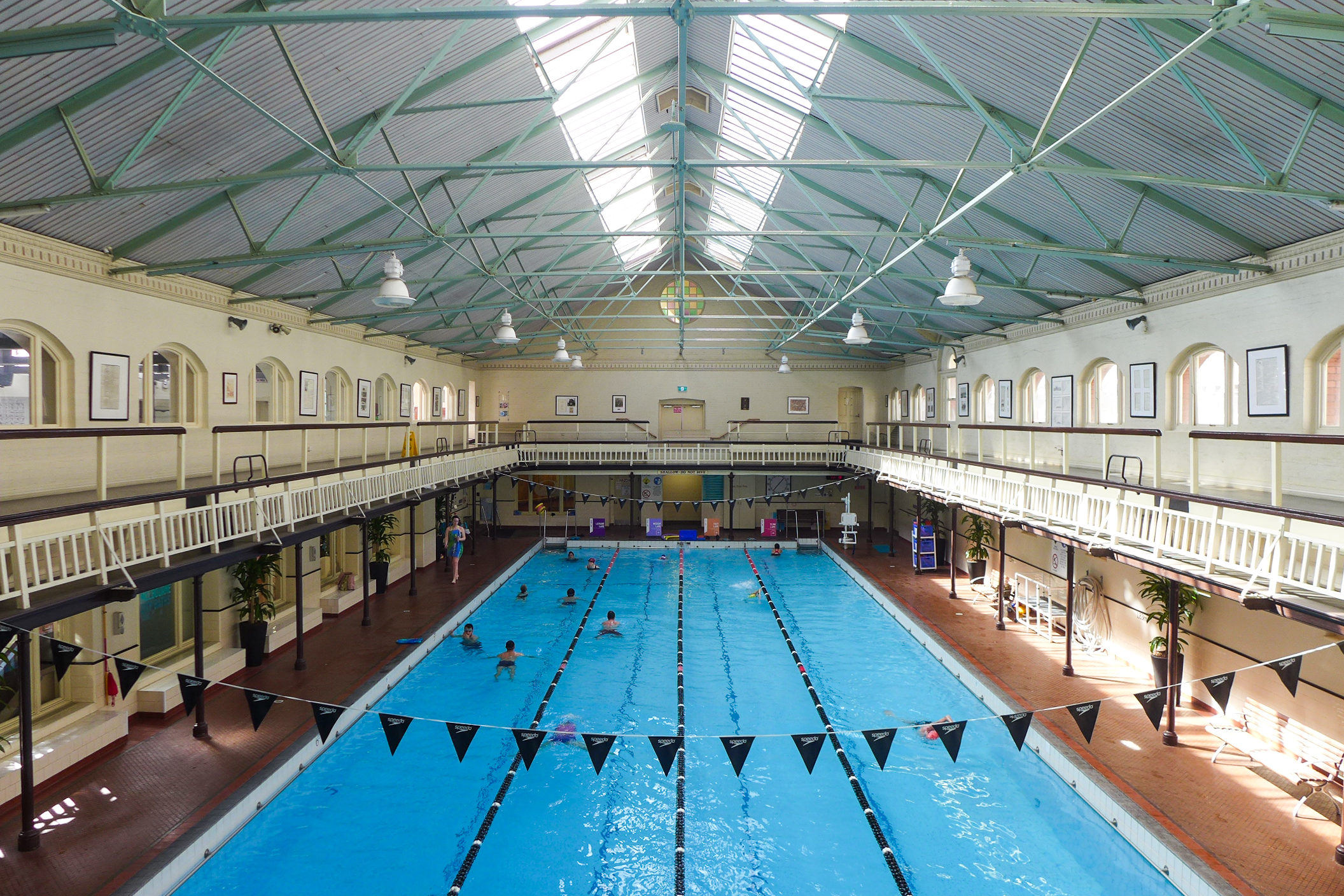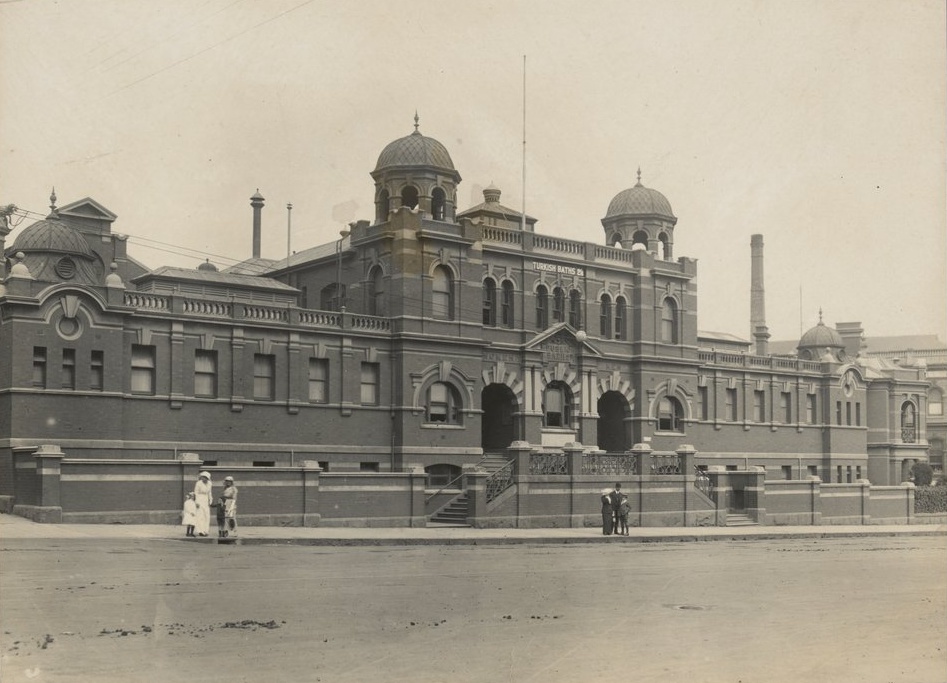City Baths, Melbourne on:
[Wikipedia]
[Google]
[Amazon]
 The City Baths, located at 420
The City Baths, located at 420
 The triangular site between Swanston,
The triangular site between Swanston,
"City Baths"
/ref>
Official website
Working drawings of the renovation
held by the City of Melbourne. {{Authority control Buildings and structures completed in 1904 Heritage-listed buildings in Melbourne Federation style architecture Romanesque Revival architecture in Australia 1904 establishments in Australia Sports venues in Melbourne Swimming venues in Australia Bathing in Australia Public baths in Australia Green bans Buildings and structures in Melbourne City Centre Sport in the City of Melbourne (LGA)
 The City Baths, located at 420
The City Baths, located at 420 Swanston Street
Swanston Street is a major thoroughfare in the centre of Melbourne, Victoria, Australia. It is one of the main streets of the Melbourne central business district and was laid out in 1837 as part of the original Hoddle Grid. The street vertically ...
, Melbourne
Melbourne ( ; Boonwurrung/Woiwurrung: ''Narrm'' or ''Naarm'') is the capital and most populous city of the Australian state of Victoria, and the second-most populous city in both Australia and Oceania. Its name generally refers to a met ...
, Victoria, Australia
Victoria is a state in southeastern Australia. It is the second-smallest state with a land area of , the second most populated state (after New South Wales) with a population of over 6.5 million, and the most densely populated state in Au ...
, opened in 1904 as public bath
Public baths originated when most people in population centers did not have access to private bathing facilities. Though termed "public", they have often been restricted according to gender, religious affiliation, personal membership, and other cr ...
s, with swimming pools and bathing facilities. Extensively renovated in the early 1980s, it is now considered one of Melbourne's most architecturally and historically significant buildings.
History
 The triangular site between Swanston,
The triangular site between Swanston, Victoria
Victoria most commonly refers to:
* Victoria (Australia), a state of the Commonwealth of Australia
* Victoria, British Columbia, provincial capital of British Columbia, Canada
* Victoria (mythology), Roman goddess of Victory
* Victoria, Seychelle ...
and Franklin streets was reserved for a public bath facility in 1850.Victorian Heritage Database"City Baths"
/ref>
Melbourne City Council
The City of Melbourne is a local government area in Victoria, Australia, located in the central city area of Melbourne. In 2018, the city has an area of and had a population of 169,961. Estimated resident population, 30 June 2018. The ci ...
opened the first City Baths on 9 January 1860, which housed public baths
Public baths originated when most people in population centers did not have access to private bathing facilities. Though termed "public", they have often been restricted according to gender, religious affiliation, personal membership, and other cr ...
(3 years after the opening of the London Baths). The objective was to stop people from bathing in the Yarra River
The Yarra River or historically, the Yarra Yarra River, (Kulin languages: ''Berrern'', ''Birr-arrung'', ''Bay-ray-rung'', ''Birarang'', ''Birrarung'', and ''Wongete'') is a perennial river in south-central Victoria, Australia.
The lower stre ...
, which by the 1850s had become quite polluted and the cause of an epidemic of typhoid fever
Typhoid fever, also known as typhoid, is a disease caused by '' Salmonella'' serotype Typhi bacteria. Symptoms vary from mild to severe, and usually begin six to 30 days after exposure. Often there is a gradual onset of a high fever over several ...
, which hit the city resulting in many deaths. However, people continued to swim and drink the water. The baths were leased to a private operator, but lack of maintenance resulted in such deterioration of the building that the Baths were closed in 1899.
After a design competition
A design competition or design contest is a competition in which an entity solicits design proposals from the public for a specified purpose.
Architecture
An architectural design competition solicits architects to submit design proposals for a b ...
was won by John James Clark
John James Clark (23 January 1838 – 25 June 1915), an Australian architect, was born in Liverpool, England. Clark's 30 years in public service, in combination with 33 in private practice, produced some of Australia's most notable public buildin ...
working in partnership with his son, Edward James Clark, construction of a new building started in 1903, and the bath was opened on 23 March 1904. Strict separation of men and women was maintained, with separate pools (the larger 30m 00 ftpool was for men), and separate street entrances. Two classes of facilities were provided, with second class cubicles containing "slipper baths" (where one end is raised and sloped creating a more comfortable lounging position) on ground level, and "first class baths" on the main floor and a mikvah and turkish bath
A hammam ( ar, حمّام, translit=ḥammām, tr, hamam) or Turkish bath is a type of steam bath or a place of public bathing associated with the Islamic world. It is a prominent feature in the culture of the Muslim world and was inherited ...
s. The popularity of the swimming pool increased with the introduction of mixed bathing
Mixed bathing is the sharing of a pool, beach or other place by swimmers of both sexes. Mixed bathing usually refers to swimming or other water-based recreational activities in public or semi-public facilities, such as hotel or holiday resort pool ...
in 1947, and it became the venue for swimming competitions.
After a period of decline and demolition threats in the 1970s, the building was saved by a Builders Labourers Federation
The Builders Labourers Federation (BLF) was an Australian trade union that existed from 1911 until 1972, and from 1976 until 1986, when it was permanently deregistered in various Australian states by the federal Hawke Labor government and some ...
green ban
A green ban is a form of strike action, usually taken by a trade union or other organised labour group, which is conducted for environmentalist or conservationist purposes. They were mainly done in Australia in the 1970s, led by the Builders Labo ...
. Later being extensively renovated and restored in 1981–83, designed by Kevin Greenhatch with Gunn Gunn may refer to:
Places
* Gunn City, Missouri, a village
* Gunn, Northern Territory, outer suburb of Darwin
* Gunn, Alberta, Canada, a hamlet
* Gunn Valley, a mountain valley in British Columbia, Canada
* Gun Lake (British Columbia), a Canad ...
Williams & Fender. The rear furnace and caretakers cottage were replaced with squash courts and gym space in a matching red brick, the pools were restored though most of the numerous changing booths were removed, most of the bath cubicles replaced with other facilities, and a single entrance stair created. The first class ladies baths with the "mikva bath" on the first floor were retained as the spa area.
The baths now house two swimming pool
A swimming pool, swimming bath, wading pool, paddling pool, or simply pool, is a structure designed to hold water to enable Human swimming, swimming or other leisure activities. Pools can be built into the ground (in-ground pools) or built ...
s, spa
A spa is a location where mineral-rich spring water (and sometimes seawater) is used to give medicinal baths. Spa towns or spa resorts (including hot springs resorts) typically offer various health treatments, which are also known as balneoth ...
, sauna
A sauna (, ), or sudatory, is a small room or building designed as a place to experience dry or wet heat sessions, or an establishment with one or more of these facilities. The steam and high heat make the bathers perspire. A thermometer in a ...
, squash courts
Squash is a racket-and-ball sport played by two or four players in a four-walled court with a small, hollow, rubber ball. The players alternate in striking the ball with their rackets onto the playable surfaces of the four walls of the court. Th ...
and a gym
A gymnasium, also known as a gym, is an indoor location for athletics. The word is derived from the ancient Greek term " gymnasium". They are commonly found in athletic and fitness centres, and as activity and learning spaces in educational ins ...
nasium. The mikveh
Mikveh or mikvah (, ''mikva'ot'', ''mikvoth'', ''mikvot'', or (Yiddish) ''mikves'', lit., "a collection") is a bath used for the purpose of ritual immersion in Judaism to achieve ritual purity.
Most forms of ritual impurity can be purif ...
bath was renovated in 2013. To cater for all types of swimmers, the swimming pool is divided into four lanes: an aqua play lane, a medium lane, a fast lane and a slow lane (or aquatic education, when swimming lessons are given).
The City Baths is the largest swimming pool in the Melbourne central business district
The Melbourne central business district (also known colloquially as simply "The City" or "The CBD") is the city centre and main urban area of the city of Melbourne, Victoria, Australia, centred on the Hoddle Grid, the oldest part of the city la ...
.
Architecture
The City Baths is one of the most significant examples of Edwardian civic architecture in Melbourne, combining Edwardian red-brick with rich cream paintedEdwardian Baroque
Edwardian architecture is a Neo-Baroque architectural style that was popular in the British Empire during the Edwardian era (1901–1910). Architecture up to the year 1914 may also be included in this style.
Description
Edwardian architecture is ...
elements, in a bold "blood and bandages" palette. The highly articulated facade wraps around the corners of the site, and the roofline is enlivened by multiple cupola-roofed belvederes, the tall pedimented gables of the pool roofs, and roof ridges and vents in red-painted corrugated iron. The three storey central entrance bay incorporates arched openings emphasised by banded voussoirs, and an open pediment on paired pilasters forming the entry, flanked by long two storey wings either side.
References
External links
Official website
Working drawings of the renovation
held by the City of Melbourne. {{Authority control Buildings and structures completed in 1904 Heritage-listed buildings in Melbourne Federation style architecture Romanesque Revival architecture in Australia 1904 establishments in Australia Sports venues in Melbourne Swimming venues in Australia Bathing in Australia Public baths in Australia Green bans Buildings and structures in Melbourne City Centre Sport in the City of Melbourne (LGA)